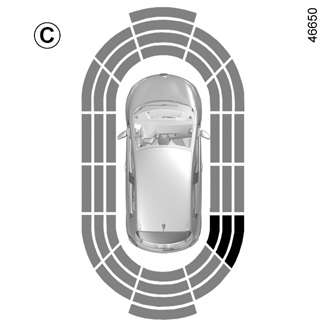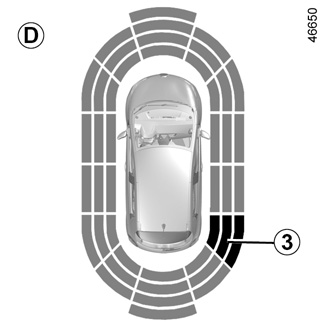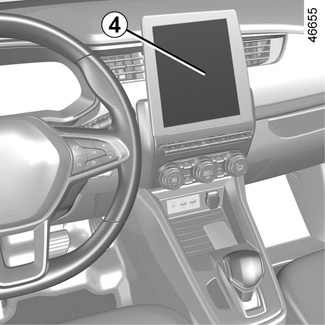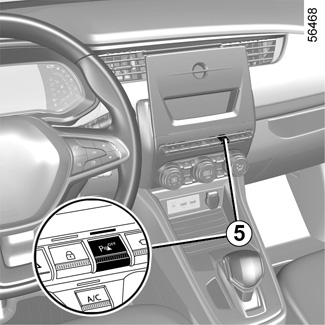PARKING DISTANCE CONTROL

Operating principle
Ultrasonic sensors, indicated by arrows 1, are fitted in the bumpers to measure the distance between the vehicle and an obstacle.
Depending on the vehicle, the system detects obstacles to the front, the rear and the sides of the vehicle.
The parking distance control system is only activated when the vehicle is driven at a speed below approximately 6 mph (10 km/h).
This measurement is indicated by beeps which become more frequent the closer you come to the obstacle, until they become a continuous beep when the vehicle is approximately 20 to 30 centimetres from the obstacle.
Location of the ultrasonic sensors 1
Ensure that the ultrasonic sensors indicated by the arrows 1 are not obscured (by dirt, mud, snow, a badly fitted/attached number plate, etc.), impacted, modified (including paintwork) or obstructed by any accessory fitted to the rear and/or, depending on the vehicle, to the front or sides of your vehicle.
This function is an additional driving aid.
Under no circumstances should it replace the driver’s care or responsibility whilst reversing.
The driver should always be ready for sudden incidents while driving: always ensure that there are no small, narrow moving obstacles (such as a child, animal, pushchair, bicycle, stone, post, etc.) in the blind spot when manoeuvring.

Vehicle fitted with a navigation system
Note: the display 2 shows the vehicle surroundings and emits beeps.
It is necessary to travel a few metres before the side detection is activated.
If all areas have a grey background, the whole area around the vehicle is being monitored:
- A: analysis of the vehicle surroundings in progress;
- B: analysis of the vehicle surroundings carried out.

Operation
Most objects located less near the front, rear and sides of the vehicle are detected.
Depending on the distance of the obstacle, the frequency of the beep will be higher while approaching it, and will become a continuous beep around 20 cm away for obstacles to the sides, and around 30 cm for obstacles to the front or rear. Depending on the vehicle, the green, orange (or yellow depending on the vehicle) and red zones will be displayed on the C display.
Note: in the event of a change in trajectory during a manoeuvre, the risk of collision with an obstacles may be signalled late.
An impact to the underside of the vehicle while manoeuvring (e.g. striking a post, raised kerb or other street furniture) may result in damage to the vehicle (e.g. deformation of an axle).
To avoid any risk of accident, have your vehicle checked by an approved dealer.

Detection of obstacles to the side
(depending on the vehicle)
Depending on the direction of the wheels, the system determines the trajectory of the vehicle and notifies the driver of any risk or otherwise of a collision with an obstacle 3 to the side of the vehicle.
If a side obstacle is detected:
- the beeps become faster and then sound continuously as the obstacle gets nearer. Green, orange and red zones will be displayed on the display D;
- if there is no risk of collision, no beep will sound when approaching the obstacle. Green, orange and red zones will be displayed interspersed on the display D.
Note: in the event of a change in trajectory during a manoeuvre, the risk of collision with an obstacle may be signalled late.
An impact to the underside of the vehicle while manoeuvring (e.g. striking a post, raised kerb or other street furniture) may result in damage to the vehicle (e.g. deformation of an axle).
To avoid any risk of accident, have your vehicle checked by an approved Dealer.

Activation/deactivation
Vehicle fitted with a navigation system
With the vehicle stationary and the engine running, from the multimedia screen 4, select the “Settings” menu, select the “Vehicle” tab, select the “Parking assistance” menu then select “ON” or “OFF” to activate or deactivate areas covered by the ultrasonic sensors.

Vehicles without a navigation system
With the vehicle stationary and the engine running, press switch 5 to activate or deactivate the function.
Setting on vehicles not fitted with a navigation system
Depending on the vehicle, with the vehicle stationary, engine running, some settings can be adjusted from the multimedia screen 4.
Please refer to the multimedia instructions for further information.
Select “Settings”, “Parking assistance”.
Parking distance control audio volume
Select “Settings”, “Parking assistance”, “Sound”. Adjust the volume of Park Assist by pressing “+” or “-”.
Setting on vehicles fitted with a navigation system (continued)
System sound
Enables the system sound to be chosen. Select “Settings”, “Parking assistance”, “Sound”.
Deactivating the system sound
Activate or deactivate the parking distance control sound.
Note: if you deactivate the sound, you will no longer be notified with beeps when approaching an obstacle.
Parking distance control automatic deactivation
The system deactivates:
- when the vehicle speed is above approximately 6 mph (10 km/h);
- depending on the model, when the vehicle is stationary for more than approximately 5 seconds and an obstacle is detected (such as when in a traffic jam, etc.);
- when you are in position N;
- when an operating fault is detected.
Operating faults
If the system detects an operating fault, a beep sounds for approximately three seconds each time the reverse gear is selected and the message “Check parking distance control” appears on the instrument panel. Check that your ultrasonic sensors are clean. If the message remains, contact an approved dealer.
When the vehicle is travelling at a speed below approximately 6 mph (10 km/h), some noises (motorcycle, lorry, pneumatic drill etc.) may trigger the beeping sound of the parking distance control.
An impact to the underside of the vehicle while manoeuvring (e.g. striking a post, raised kerb or other street furniture) may result in damage to the vehicle (e.g. deformation of an axle).
To avoid any risk of accident, have your vehicle checked by an approved dealer.
System servicing/repairs
- In the event of an impact, the alignment of the sensors may be altered and their operation may consequently be affected. Deactivate the function and consult an authorised dealer.
- Any work in the area where the sensors are located (repairs, replacements, etc.) must be carried out by a qualified professional.
Only an authorised dealer is qualified to service the system.
System disturbance
Some conditions can disrupt or damage the operation of the system, for example:
- poor weather conditions (rain, snow, hail, black ice, etc.);
- in the event of exposure to strong electromagnetic waves (under high-voltage lines, etc.);
- some types of noise (motorcycle, lorry, pneumatic drill, etc.).
Risk of false alarms or absence of warnings
In the event of the system behaving abnormally, deactivate it and consult an authorised dealer.
Limitation of the system operation
- The area around the sensors must be kept clean and free of any modifications in order to ensure the proper operation of the system.
- Small objects moving close to the vehicle (motorcycles, bicycles, pedestrians, etc.) may not be recognised by the system.
- The system may not detect objects that are too close to the vehicle.
- The system may not provide a warning when the other vehicles or objects are travelling at a significantly different speed.
- During a change in trajectory, during a manoeuvre, the system may report obstacles with a delay.
Deactivating the function
You must disable the function if the sensor area has been damaged (rear bumper).